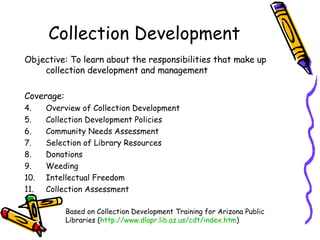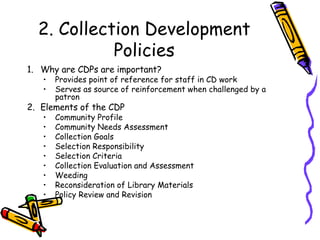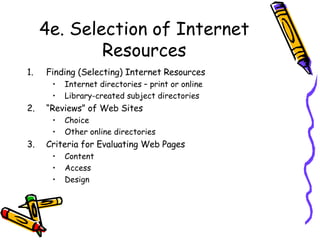Lecture 1c: Collection Development
- 1. Lecture 1c: Collection Development Development and Management of Collections
- 2. Collection Development Objective: To learn about the responsibilities that make up collection development and management Coverage: Overview of Collection Development Collection Development Policies Community Needs Assessment Selection of Library Resources Donations Weeding Intellectual Freedom Collection Assessment Based on Collection Development Training for Arizona Public Libraries ( http:// www.dlapr.lib.az.us/cdt/index.htm )
- 3. 1. Overview of Collection Development Basic Functions Functions that are performed by every library Includes: Selection of library materials Weeding Intellectual Freedom Donations Umbrella Functions Functions that serve to inform about the library’s collection development policy itself Includes: Collection Development Policy Community Needs Assessment Collection Assessment
- 4. 2. Collection Development Policies Why are CDPs are important? Provides point of reference for staff in CD work Serves as source of reinforcement when challenged by a patron Elements of the CDP Community Profile Community Needs Assessment Collection Goals Selection Responsibility Selection Criteria Collection Evaluation and Assessment Weeding Reconsideration of Library Materials Policy Review and Revision
- 5. 2. Collection Development Policies (cont’d) How to write a CDP? Determine who will write the policy Gather data Write the policy Get the policy approved Revise your policy Sample CDPs on the Web ACQWeb’s Directory of CDPs on the Web ( http://acqweb.library.vanderbilt.edu/cd_policy.html )
- 6. 3. Community Needs Assessment What a Needs Assessment Can Do for You? To determine how well the collection meets the needs of your community To identify the types of resources and services your library can provide in the future Performing a Needs Assessment Who will conduct the study? What kind of information will be collected? How will the information be collected? How will the information be used?
- 7. 4. Selection of Library Resources Selection Philosophies The five laws of S. R. Ranganathan: Books are for use. Every reader his book. Every book its reader. Save the reader's time. A library is a growing organism. “ Demand” vs “Quality How to be a Good Selector? Stay abreast of publishing trade Know your community well Be aware of current events and popular culture trends
- 8. 4. Selection of Library Resources (cont’d) Selection Criteria in General Subject Matter Construction Quality Potential Use Relation to the Collection Bibliographic Considerations Costs
- 9. 4a. Selection of Books Selection Considerations Fiction – “classics” vs Bestsellers and other popular fiction Non-Fiction – resources that answer most ready-reference questions Evaluation Criteria for Book Selection Fiction – Based on knowledge of community’s reading interests Non-Fiction – Based on factors such as authority, currency, scope, interest, organisation, format, special features, cost, accuracy, and impartiality. Selection Tools Selective Resources Book Reviews “ Best of” and Recommended Lists Subject Lists Comprehensive Resources Publisher Sources Online Bookstores Directory of In-print and Out-of-print Books National Bibliographies
- 10. 4b. Selection of Audiovisual Materials Selection Criteria Involve primary users in selection Preview, if possible Budget allocated Durability Visual and audio quality Ease of repair Equipment required Likelihood the audiovisual technology is long-lasting
- 11. 4b. Selection of Audiovisual Materials (cont’d) Video materials Extremely popular medium, includes videocassettes, VCDs, & DVDs Technical aspects: sound and picture synchronisation; video formats (PAL vs NTSC); Regional code for DVDs; sound systems (Dolby, etc.); etc. Content: accuracy of information; presentation style; etc. Tools: Library Journal, Video Librarian, View Finder, Sight & Sound Audio materials Includes audiocassettes, audio books, CDs Music or Non-Music
- 12. 4c. Selection of Periodicals Selection Issues Selection Criteria Purpose, scope and audience Accuracy Local interest Format issues Indexing Cost Demand Availability Selection Tools Selective guides Directories of periodicals and newspapers Publisher catalogues Periodical lists Electronic Journals and Magazines
- 13. 4d. Selection of Electronic Resources Evaluation Criteria for Electronic Resources (includes CD-ROMs, and online resources) Content considerations Access considerations Technical support considerations Cost considerations Legal considerations Selection Tools Trial versions/periods Visit or talk to librarians who have the resource in their library Review sources: Library Journal Journals: Online, Database
- 14. 4e. Selection of Internet Resources Finding (Selecting) Internet Resources Internet directories – print or online Library-created subject directories “ Reviews” of Web Sites Choice Other online directories Criteria for Evaluating Web Pages Content Access Design
- 15. 5. Donations The Importance of a Gift Policy Conditions for accepting gifts Possible uses of donations Apply same objective selection criteria as purchasing new books Library reserves the right to accept, reject, sell or otherwise dispose of donated materials Local and/or Historic Materials Problematic Materials Condition of donated material Donation of someone’s collection of old books and periodicals Consider time, space and effort available for processing Gifts to Encourage Other Ways to Involve the Public
- 16. 6. Weeding The Importance of a Weeding Policy Weeding is a periodic/continual evaluation of resources with intention to remove items that are no longer useful from the collection A Weeding Policy will guide library staff in making the decision to retain or remove items from the collection It will help the community understand the reasons for removal of items Why Weeding is Necessary? Make the collection more relevant and up-to-date Remove outdated or worn-out materials, making the collection more visually attractive and inviting to users Identify gaps in collection from removal, which can then be replaced with newer purchases Draw attention to increase circulation of previously overlooked items
- 17. 6. Weeding (cont’d) Why it doesn’t get done? Planning your approach C ontinuous R eview, E valuation and W eeding Getting down to business M isleading and/or factually inaccurate; U gly (worn out beyond mending or rebinding); S uperseded by a new edition or a better source; T rivial (of no discernable literary or scientific merit); I rrelevant to the needs and interests of your community; E lsewhere (the material may be easily borrowed from another source). Now what? Keep? Keep but mend first? Replace with new copy? Don’t keep: Sell it? Give it away? Destroy it? Updating the catalogue
- 18. 7. Intellectual Freedom Considerations during Selection Labeling: PG13, NC16, M18 Illegal acts, obscenity & profanity Balance: gender/sex, racism, questionable truth, popular material Items likely to be stolen Handling Challenges to Materials in Your Collection Keep your policies and procedures current Have a formal policy to handle complaints Have open lines of communication with local community leaders Communicate the library’s position on intellectual freedom Internet Use Policies
- 19. 8. Collection Assessment Benefits of Conducting an Assessment How Collections are Measured? Quantitative vs Qualitative Assessment Techniques Examination of shelf-list data Direct examination of collection List checking Evaluation by an outside expert Citation analysis
- 20. 8. Collection Assessment (cont’d) Assessment Framework: The Conspectus Division by subject Collection codes Current collection Acquisition commitment Collection goal Preservation commitment Collection levels 0 – Out of scope 1 – Minimal level 2 – Basic information level 3 – Study or instructional support level 4 – Research level 5 – Comprehensive level Comments



















